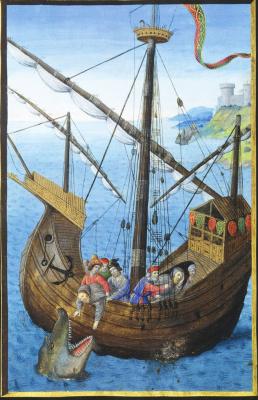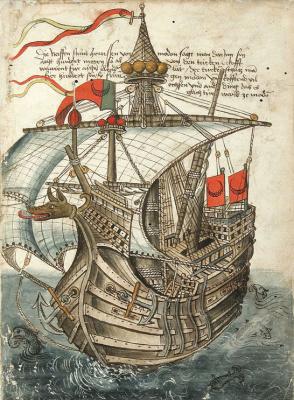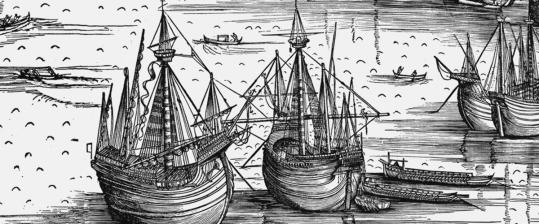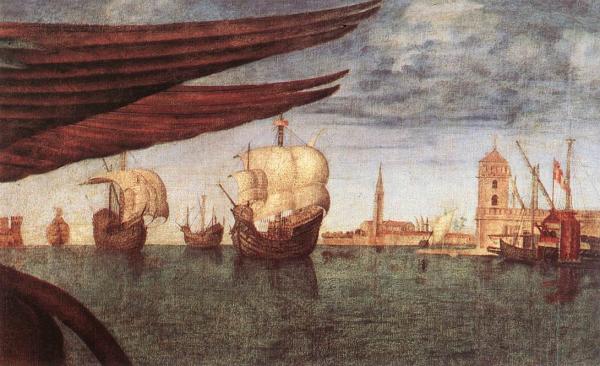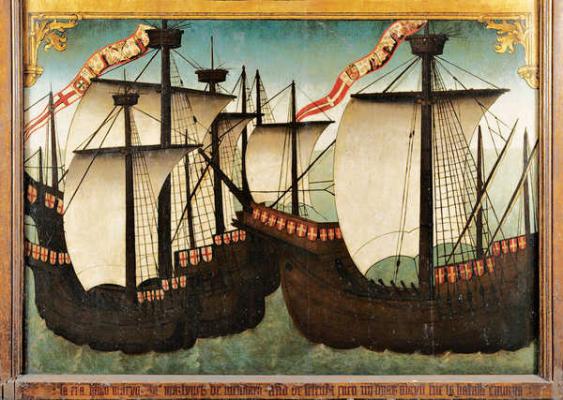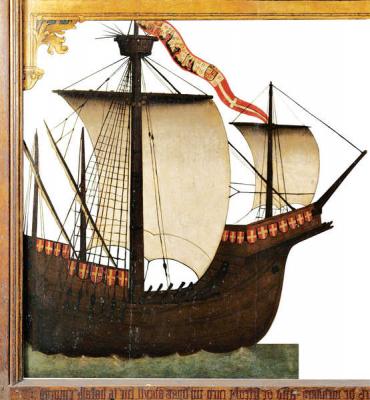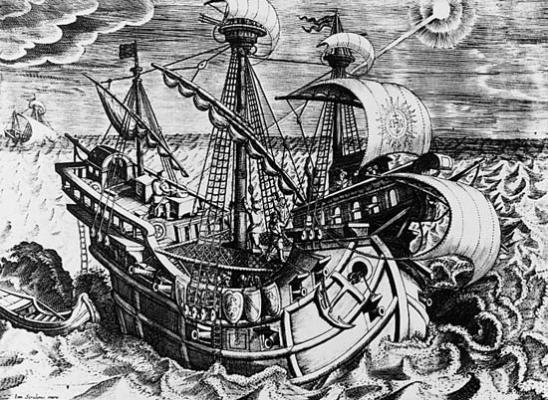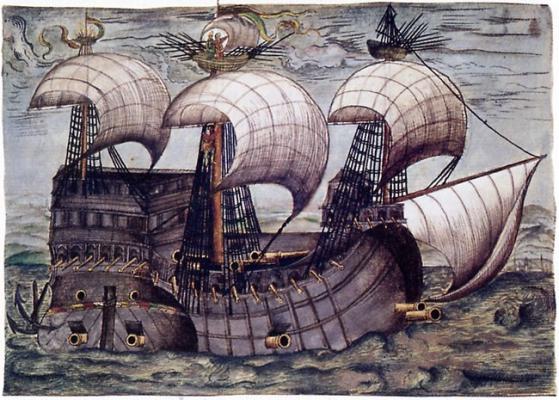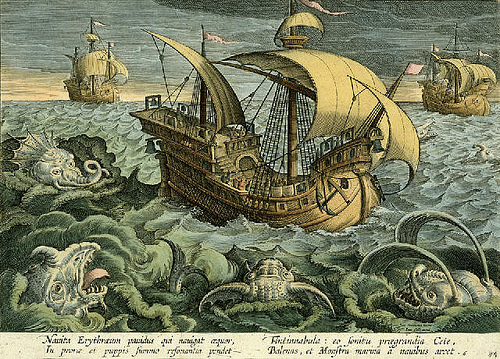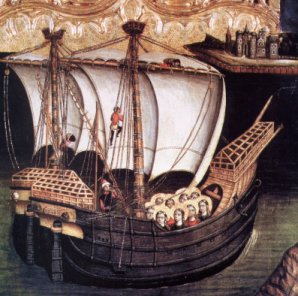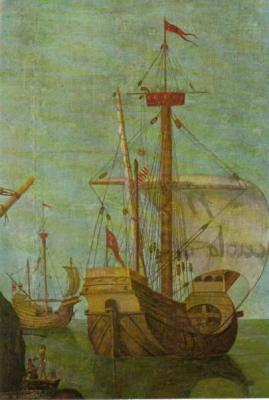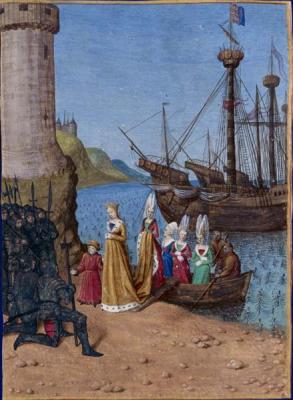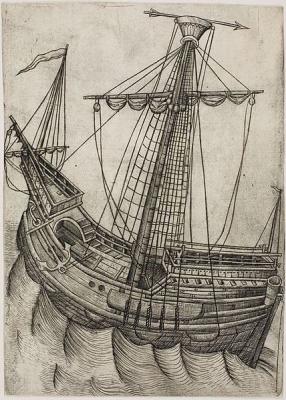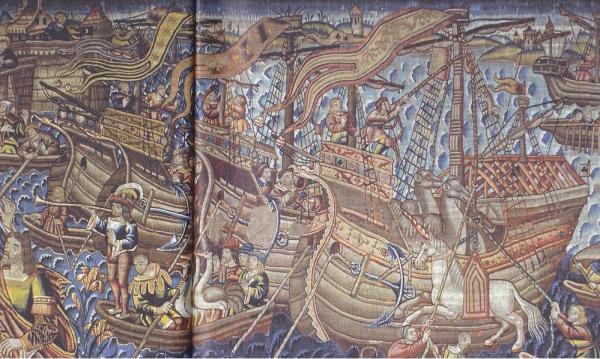-
Posts
7,572 -
Joined
-
Last visited
Content Type
Profiles
Forums
Gallery
Events
Everything posted by Louie da fly
-
That's a very nice build. Regarding the colour, I googled the Oseberg ship to find out what timber she was made of, and of course it turned out to be oak. So when she was new she would have been nice and golden-brown. But if you like it darker, as it is in the museum - hey, it's your model and you should choose what you want. By the way, there were a lot of grave goods found in the ship, including a 4-wheeled ceremonial cart, 3 beds, a bucket, textiles, and a wooden chest, as well as the bodies of two women - thought to be Queen Asa and a handmaiden. See here for some images.
-
Dick, your noting of the asymmetrical frame over the forecastle and the idea of scuppers within the protruding deck beams are very interesting. Full marks for observation! By the way, I've just found some high res pics of Tavola Strozzi's 1465 painting of the return of the Aragonese fleet to Naples after the Battle of Ischia, with some nice pics of carracks. They're at http://commons.wikimedia.org/wiki/File:Tavola_strozzi_(flotta_aragonese_al_ritorno_della_battaglia_di_ischia_il_12_luglio_1465),_1465-1500_ca.,_11982,_02.JPG and http://commons.wikimedia.org/wiki/File:Tavola_strozzi_(flotta_aragonese_al_ritorno_della_battaglia_di_ischia_il_12_luglio_1465),_1465-1500_ca.,_11982,_08_pontile.JPG. Click on each pic to zoom in. And better res pics of Carpaccio's Legend of St Ursula at http://www.lessingimages.com/search.asp?a=L&lc=202020204423&ln=Galleria+dell'Accademia%2C+Venice%2C+Italy&p=1 These are somewhat obscured by the watermark but if you click on each picture, and then click again, you can get a zoom with very good detail - better than I've managed to find before. Hope these are helpful. Steven
-

Batavia by *Hans* - FINISHED
Louie da fly replied to *Hans*'s topic in - Build logs for subjects built 1501 - 1750
Very nice. I grew up in Western Australia, with stories of the Batavia massacre. The remnant of the ship's stern has been rebuilt and is on display in the Fremantle Shipwreck Museum, along with cannons and a considerable number of artefacts from the wreck. There is a copy of the stone gateway for the Batavia fort that was shipped as ballast on the Batavia - the original is in Geraldton, the nearest town to the actual site of the shipwreck. There is at least one West Australian who's on this forum (I'm over the other side of Australia, 4000 km away). -
Very nice. Good to see her taking shape. Dan, from Vivien's log I see you're planning to make that carrack as a waterline model. That's the ship from the Beauchmp Pageant mentioned above, and the sail bears the arms of Richard Beauchamp, Earl of Warwick. Are plans available for her, or have you drawn them up yourself? Steven
-
Thanks for all the info on dromons. And Dick, sorry for derailing this thread - getting back to the subject, I just remembered a link I have to a site on the early 15th century ship designer Michael of Rhodes, containing a facsimile of his manuscript, complete with theoretical diagrams and a number of pics, including one of a carrack. You can find it here. Steven
-
Oh, and of course the Henry Grace a Dieu itself was really just a carrack with delusions of grandeur. Yes, considering nobody really knows exactly what they looked like, contemporary pictures are sketchy and stylised, and the author of the best surviving contemporary description was no seaman, and was more concerned with showing off his classical Greek scholarship than in describing the ships in use at the time. Much of his description relates to ancient Greek galleys from 1200 years earlier! Fortunately in 2004 during railway excavations in the suburb of Yenikapi in Istanbul, where Constantinople's Harbour of Theodosius had once been, the remains of 37 shipwrecks from the 5th to 11th centuries AD were discovered. A few of these were military galleys - the largest being a galea, the next step down from a dromon. Unfortunately, only the hull below the waterline was preserved. So how a dromon actually looked and worked is still largely a mystery.(sigh) I've been collecting information for some time, as many contemporary pictures as I can, papers on modern theoretical reconstructions etc so I can work up my own reconstruction when the time comes. It's all part of the fun. I'm sure you'll get around to finishing it off eventually. One for the back burner. And I only just realised Le Gros Ventre is one of yours, too. I've been following that one with great interest. Great stuff. Look forward to seeing your progress.
-
Lots of things. I'm just getting bck into ship modelling after several decades. I have a POB model of Henry VIII's Henry Grace a Dieu which I made in the 1960's when I was in my teens, based on the reconstruction in Bjorn Landstrom's book The Ship. I pulled the stern off when I realised it was wrong, and never got back to it. So fixing it up will be my first project, and then I have quite a number of possibles lined up - perhaps a carrack or a cog or a Byzantine dromon, I'm just not sure. But first the admiral and I have to finish renovating the house - so everything's on hold till then (sigh). Steven
-
Yes, that looks really good - and I believe the extra hull volume at the bow would give extra buoyancy there, and make the ship perform better in a sea (though I'm no expert on these matters). Looks very much like the shape on the Mataro ship as well. I'm fascinated by the documentation you cite - I hadn't heard of it before. I'm still very much a beginner in research on this subject (but very keen!) Though the pictorial record is useful as a back-up, it's of course not as reliable due to artistic licence, and it doesn't contain all that many actual side elevations of carracks - very often they're viewed from slightly sternward, which distorts the proportions. However, the Beauchamp Pageant and the Spanish(?) carracks on the previous page of this thread have very good side elevations, and they show a stempost very much of the shape of your latest version, (though of course they have to be taken with a pinch of salt when thinking about Venetian carracks). Looking good. Steven
-
Yes. Though rigging for this period is a fascinating (and largely unknown) subject, it doesn't come till quite a way down the track - the first thing is to get the hull made. Just a point with the hull shape - I was wondering if the stempost mightn't have a bit too much rake? The original picture you're taking your model from is seen from slightly sternwards and that always exaggerates the rake of the stem, just as a bow-on view makes it look less. Just a suggestion, and feel free to ignore it if you disagree.
-
That ship is a thing of beauty. Yes, TAMU's site is a wonderful resource. Unfortunately, they don't seem to have looked at standing and running rigging. There may be better books out there, but Wolfram zu Mondfeld's Historic Ship Models contains the best outline I've yet seen of the evolution and development of ships' rigging in the period we're interested in. He gives rough dates for when certain features appeared (such as deadeyes for the topmast shrouds, backstays for upper masts etc). However, even the information he provides is a bit thin, probably because there's so little of it around. And as his source is probably the same we're working off - contemporary pictures - he should be used as a guide only, and only as a general picture. If you have information more specifically appropriate to your own model, it should probably take precedence. You can get the book from abebooks second hand for not too much (it's quicker from the UK than from the US). If you like I can PM you photocopies of a few relevant pages. Steven
-
I don't know if this is any help, but there's a paper here by Texas A&M University, reconstructing the sail plan of a Portuguese nau. Though the ship in question sank in 1606 their supportive documentation goes back to 1500 and may be useful. It's sails only, however, not rigging as such. There's an accompanying paper reconstructing the hull here
-
I found some more information trawling the Net, and particularly contemporary pictures of carracks, which might help with rigging if you decide to go that way. I got most of them from a flickr collection put together by a computer gamer called ModernKnight1. It's a mixed bag, and I've picked the eyes out of it - including (as far as I can judge)only actual contemporary representations appropriate to your model and leaving out later copies, reconstructions etc. I have to hand it to ModernKnight1 for persistence and dedication. That's a heck of a collection of stuff and his site's well worth a visit. Several pictures of Mediterranean carracks of the mid-late 15th century show what appear to be small groups of ratlines at intervals up the shrouds. No use as ladders, but perhaps to keep the shrouds together? Jonah and the whale (date and source unknown) has them, as does Modern Knight 1's "Unknown Carrack 3" (the text is in German, but the flags are crescent moons - perhaps supposed to be a Turkish ship? "Venice carracks", which appears to be a detail from de Barberi's view of Venice have them as well. Reixach's St Ursula retable (Catalan, 1468)doesn't show them, and neither does another of Carpaccio's St Ursula series - the departure of the pilgrims (partenza dei pellegrini). Modern Knight 1's "Carracks in Venice" hasn't enough detail to be certain if they're there or not. The Venetian woodcut of the 1499 Battle of Zonchio doesn't show them, either. There are some other worthwhile representations of carracks in Modern Knight 1's site, all with conventional ratlines, such as two which appear to be Spanish if the banners at the mastheads show (as they appear to) the coat of arms of the combined kingdoms of Castile and Leon. Lacking any other identification I've called them "Modern Knight1 Unknown Carracks 4 and 4A". And then there's the wierd ones; I think they're simply bad art, and not very good representations (or in one case a really bad one) of contemporary carracks, but they may contain useful information. I hope this is of use in your model. I've certainly had fun chasing it all up. Just love those carracks! Steven
-
Happy to help. Though the Beaumont stuff is is a record of happenings some decades earlier, the pics date from about 1485, and I think we can safely assume the artist portrayed ships of his own time rather than those of a few decades earlier. When I first looked at it I thought there were only about 3 or 4 pics in it, but on looking at it again I realised I'd missed a lot on my first view. I agree the detail is very convincing and I'm prepared to accept it as an accurate depiction of what was actually used at the time. Here's a link to a contemporary picture of Venetian and Turkish carracks in battle in 1499, which has some interesting details. And a bowl from Moorish Spain c. 1450 here and the bottom picture here I also did a quick image search for Jacopo de Barbari's view of Venice of 1500, from which Landstrom got one of his reconstructions - you can see the results here. Didn't have time to go to all the websites shown, but you might find one that blows up enough to give good details of ships. Some examples I was able to find are here, and a detail photo of one of the original wood blocks here. Your model is nothing short of magnificent. Keep up the good work.
-
I had a look at the Landstro"m book last night. It really is an excellent book, but there's not all that much about Mediterranean carracks of the time you're interested in. Maybe there's very little extant information available at all. But one thing is that in the Mediterranean they were quite late putting ratlines in the shrouds - your model is probably from around about the time of transition. So rather than ratlines, perhaps just a single rope ladder per mast. I'll see what else I can find out.
-
The engraver Master W.A. (Willem A. Cruces, ca. 1468) can be very useful for rigging, though as he was based in Flanders it's a moot point how much of the rigging he shows is appropriate to Venice. this link is to a pdf on the rigging in his engravings and those of others. WARNING - it's at least 10 MB of download. There's also the ships of the Beauchamp Pageant (English, about the same time)shown here. Unfortunately the pictures are extremely faint, but there is a good zoom function and you can get pretty good detail despite the faintness. You can see ships at pages 17,19,29,31,45,49,51,71,73,97 and 99. Again, perhaps not appropriate to Venice. I've also attached a few contemporary pictures that may be of help. Unfortunately the tapestry of Vasco da Gama's arrival in India was done not in Portugal (which might have helped with Mediterranean rigging) but in Tournai in Flanders. I'm going to have a look at my copy of Landstro"m's The Ship. I'm pretty sure it has more pics of Mediterranean vessels of the the right period which might be of help.
-
There's something enchanting about a carrack. A much under-represented form, in my opinion. You can keep your clippers and frigates; I don't think you can go past a carrack for a sort of ungainly elegance. Reconstructing the shape using only contemporary representations is difficult but rewarding. It really looks good - keep up the good work.
About us
Modelshipworld - Advancing Ship Modeling through Research
SSL Secured
Your security is important for us so this Website is SSL-Secured
NRG Mailing Address
Nautical Research Guild
237 South Lincoln Street
Westmont IL, 60559-1917
Model Ship World ® and the MSW logo are Registered Trademarks, and belong to the Nautical Research Guild (United States Patent and Trademark Office: No. 6,929,264 & No. 6,929,274, registered Dec. 20, 2022)
Helpful Links
About the NRG
If you enjoy building ship models that are historically accurate as well as beautiful, then The Nautical Research Guild (NRG) is just right for you.
The Guild is a non-profit educational organization whose mission is to “Advance Ship Modeling Through Research”. We provide support to our members in their efforts to raise the quality of their model ships.
The Nautical Research Guild has published our world-renowned quarterly magazine, The Nautical Research Journal, since 1955. The pages of the Journal are full of articles by accomplished ship modelers who show you how they create those exquisite details on their models, and by maritime historians who show you the correct details to build. The Journal is available in both print and digital editions. Go to the NRG web site (www.thenrg.org) to download a complimentary digital copy of the Journal. The NRG also publishes plan sets, books and compilations of back issues of the Journal and the former Ships in Scale and Model Ship Builder magazines.



